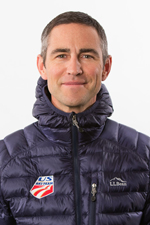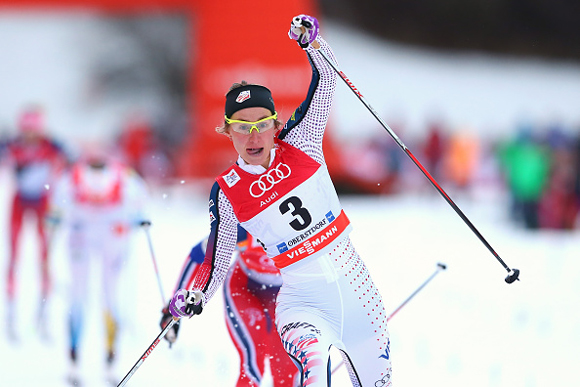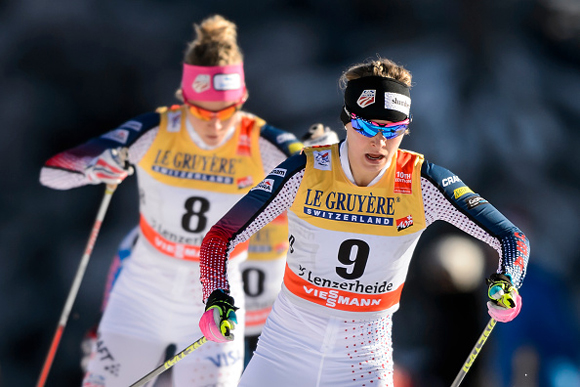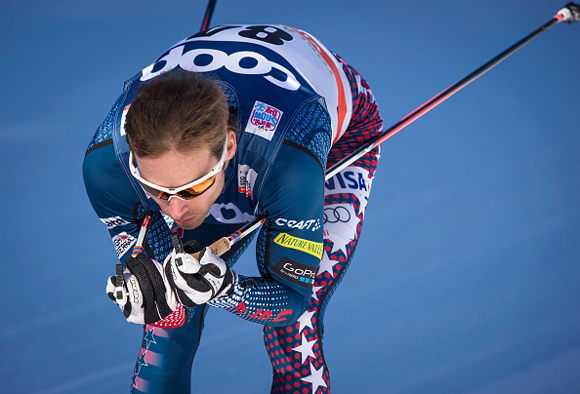 Chris Grover, the U.S. Cross Country Ski Team’s head coach, has had a heck of a year so far. With two stage wins at the Tour de Ski, a myriad of career-best results for various athletes and top 10s galore, the team is looking strong for the next few months of racing. We chatted with him from the Dolomites to discuss the Tour de Ski and the rest of the upcoming season.
Chris Grover, the U.S. Cross Country Ski Team’s head coach, has had a heck of a year so far. With two stage wins at the Tour de Ski, a myriad of career-best results for various athletes and top 10s galore, the team is looking strong for the next few months of racing. We chatted with him from the Dolomites to discuss the Tour de Ski and the rest of the upcoming season.
U.S. SKI TEAM: First of all, congratulations on a great season so far – especially with two stage wins at the Tour de Ski.
CHRIS GROVER: It’s been very gratifying to see all of the hard work put in by these athletes over the summer and fall pay off over the past few weeks. We felt we had a good preparation period last summer and fall and it was nice to see that translate into results.
CHRIS GROVER
U.S. SKI TEAM: Leading into the Tour de Ski, the team had some good success. Talk about some of the season highlights and how it motivated the team for the Tour de Ski.
CG: During World Cup Period 1, almost every athlete on the Team had a standout race. Andy Newell’s fourth place finish in the Ruka classic sprint set the tone for what was possible. Sadie Bjornsen’s solid Ruka Tour finishes solidified her place as an all-arounder who would be competitive in every discipline (classic, skate, distance, sprint) and a threat in each Tour stage this winter. The women’s relay podium in Lillehammer the following weekend surprised a lot of people, but not those of us who know the tenacity and fighting spirit of our women’s team. Jessie Diggins was fearless and unrelenting in that closing relay leg and put that Team back on the podium once again. Erik Bjornsen also skied the fastest second classic leg of the men’s relay and really put his team in the mix. Sophie Caldwell’s sixth in the Davos sprint and seventh in Toblach demonstrated a full return to sprint form after a year plagued with injuries in 2014-15. And Simi Hamilton’s sprint podium in Toblach just before Christmas proved what we had seen all fall - that he is in absolute top form this season. All of these results built the confidence of the Team leading into the Tour.

Erik Bjornsen competes ahead of France's Adrien Backscheider during the men's 30 km Mass start race at the Tour de Ski event on January 2, 2016 in Lenzerheide. (Getty/AFP-Fabrice Coffrini)
U.S. SKI TEAM: This year the USA had a record 11 athletes start the Tour. It’s quite a contrast to just a few years ago when the team wasn’t even competing in Tour de Ski.
CG: We have a lot of depth on the Team right now and that has translated to more Tour starts. The depth is illustrated by the fact that we had two different stage winners on the Tour without our main podium-producer Kikkan Randall with us this season. But we also have a year with no World Championships, so the Tours became one of the main focal points of the season for many teams.

Sophie Caldwell celebrates winning the Ladies 1.2km Classic Sprint Competition during day 1 of the FIS Tour de Ski event on January 5, 2016 in Oberstdorf, Germany. (Getty/Bongarts-Alexander Hassenstein)
U.S. SKI TEAM: What kind of strengths does it take for a skier to compete successfully at the Tour?
CG: It’s quite an athletic achievement to be able to race hard on the Alpe Cermis in the eighth day of grueling World Cup racing in 10 days. For an athlete to still be healthy and to be able to dig down and find the strength and the energy reserves to really compete is astounding. There are not so many human beings on the planet with that kind of resilience and strength. The USA staff and athletes did a great job of keeping almost everyone healthy during this Tour. But the athletes have to really know themselves and understand their own limitations. They must be able to know the sensations associated with mild fatigue, severe fatigue, the first stages of illness, etc. and recognize how to measure their energy output each day.
U.S. SKI TEAM: Sophie had been fourth in the opening freestyle sprint, but were you surprised at her win in classic?
CG: We were all pleasantly surprised and I’m guessing Sophie was as well. After all, this was the very first World Cup classic sprint win for a USA athlete male or female. In the last few years, Sophie has been working hard to improve her upper-body strength and specifically her double-poling. Prior to the 2014-15 season she had a major setback by breaking both arms in separate dryland training accidents. This year she had an excellent preparation season and was able to add muscle mass and increase strength. In the Oberstdorf sprint, Sophie skied each round with such smart tactics and in the finals we saw her time her winning move with absolute precision. Her improved strength and double-pole power allowed her to hold off the Norwegians in the last few meters.

Jessica Diggins competes ahead of her compatriot Sadie Bjornsen during the women's 5 km Free Pursuit race during the Tour de Ski event on January 3, 2016 in Lenzerheide. (Getty/AFP-Fabrice Coffrini)
U.S. SKI TEAM: Jessie had already been having a strong tour, but do you think Sophie’s win was a motivating factor for her winning performance in the 5k freestyle?
CG: According to Jessie, her teammates’ results are big a motivator for her. Her win in Toblach can be attributed to a number of factors including her ability to sustain the daily demands of the Tour, her mental toughness, great skis and a course that played to her strengths. The race course in Toblach is a great one for Jessie: lots of uphill V2 terrain and lots of gradual downs and flats towards the end of the course. Jessie has an uncanny ability to push extremely hard with the legs towards the end of the race when she and her competitors are fatigued. She’s a very tough competitor and really hard to beat in the last kilometers. In Toblach, Jessie charged out of the gate, setting one of the fastest times at the early checkpoints, but it’s how she closed out those last two kilometers that gave her the win over the Norwegians.
U.S. SKI TEAM: Kikkan Randall is taking the year off to start her family but her presence is still felt here?
CG: Kikkan’s presence is surely felt by the Team. She really set the bar for the women’s group in terms of what kinds of results were possible and how an optimistic and positive attitude were critical for success. That attitude clearly is present with this Team even in Kikkan’s absence and it’s an important element in the Team’s continued success.
U.S. SKI TEAM: Beyond the wins of Sophie and Jessie, there are a few other success stories on the Tour.
CG: There are quite a few standout performances from the USA squad during the Tour. In the Lenzerheide sprint we had three women in the top eight between Sophie, Sadie and Jessie. Sadie was so strong throughout the Tour and made her presence felt in just about every stage. Noah Hoffman seemed to get stronger as the Tour progressed and had some of his best races in the last few stages, including a 19th in Toblach and the 15th fastest time in the final climb. And Liz Stephen demonstrated that she is still one of the best three hill climbers in the World by racing to the third fastest time up the Alpe Cermis.

Noah Hoffman competes during FIS Cross Country Relay Classic/ Free at Birkebeineren Stadion on December 06, 2015 in Lillehammer, Norway. (Getty Images-Trond Tandberg)
U.S. SKI TEAM: The Tour may be finished but there’s still two months left on the World Cup tour. Where do you go from here?
CG: There is a lot more racing to come. Those athletes who completed the full Tour will now head to Seiser Alm to recover and then begin training again. The sprinters are in Toblach preparing for the sprint World Cup races next weekend in Planica. We are really looking forward to checking out the new venue and the new race course that they’ve built in Planica over the next few years. After Planica, the entire Team will meet back up in Nove Mesto for a distance skate race and a relay. Both Planica and Nove Mesto are important race weekends for us with races that we are targeting as individuals and as a Team.
U.S. SKI TEAM: The U.S. athletes essentially move to Europe for nearly four months every season. How important is the connectivity with fans?
CG: The fan support coming from the USA is huge for these athletes. It can get a little lonely at times for everyone being so far from home for so long each winter. The positive energy coming from home keeps these athletes pushing hard.

Andrew Newell during FIS Cross Country World Cup Men 15.0 km Individual Start at Toblach on December 20, 2015 in Toblach Hochpustertal, Italy. (Getty Images-Trond Tandberg)
U.S. SKI TEAM: This year the World Cup finale comes to North America with two weeks of racing in Canada. How will that help the team to get home early and showcase the sport for U.S. fans?
CG: The Ski Tour Canada is perhaps our biggest focus of the season. We’ll have 24 USA men and women racing that Tour. The athletes are already stoked to compete there in front of all of the North American fans. We had a big USA fan turnout in Quebec City for the World Cup there in 2012 and we’re hoping everyone comes north once again to cheer on so many US athletes. As you might imagine, we’ll have a bit of a home-course advantage by forcing the Europeans to come our time zones for a change. You can expect more big USA results in Canada!
